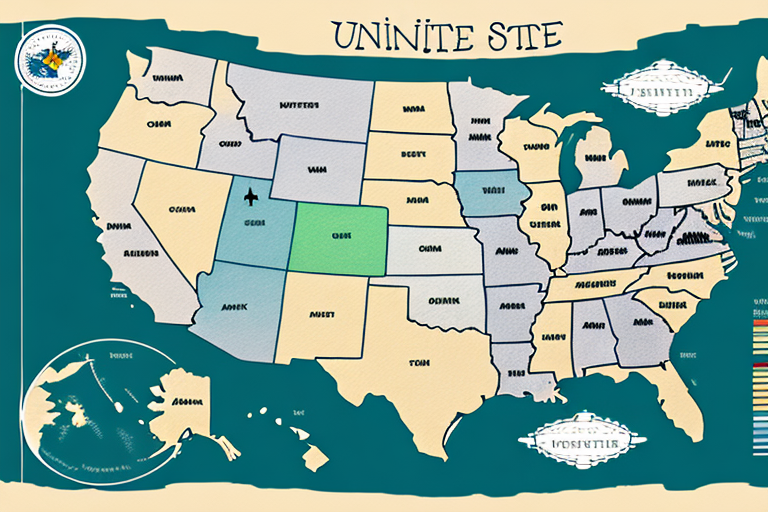Understanding UPS Shipping Rates for Different States
When shipping goods across the United States, UPS remains one of the most popular carriers for businesses of all sizes. However, businesses often face varying shipping rates depending on the shipment's destination, which can be both frustrating and confusing. In this article, we will provide an in-depth analysis of UPS shipping rates, exploring how they are calculated, the factors influencing them, and strategies to secure the best deals when negotiating with the carrier. By the end of this article, you'll have a comprehensive understanding of UPS shipping rates across different states and how to optimize them for your business needs.
How UPS Calculates Shipping Rates
Before diving into the specifics of UPS shipping rates, it's important to understand how the carrier calculates them. UPS determines the cost of shipping based on several key factors, including the package's weight, dimensions, destination, and desired delivery time. All of these factors are considered when creating a shipment in the UPS system.
In addition to these factors, UPS offers various shipping options that can affect the overall cost. For example, customers can choose to add insurance to their shipment, which increases the total cost. Additionally, UPS provides different delivery speeds, such as next-day or ground shipping, which can also impact the final price. Carefully considering these options when creating a shipment ensures that you receive the best value for your money.
For the most accurate and up-to-date rate calculations, refer to the UPS Rate Calculator.
Factors that Affect UPS Shipping Rates
Several factors influence the overall cost of UPS shipping rates. One of the primary factors is the package's weight and size. The heavier or larger the package, the higher the shipping rate. Another key factor is the shipment's destination. UPS shipping rates are calculated based on shipping zones, which consider the distance between the origin and destination. The greater the distance, the higher the shipping rate.
Additionally, the type of shipping service chosen—such as ground, air, or expedited services—affects the cost. Higher-tier services like next-day delivery will naturally cost more than standard ground shipping. The declared value of the package also plays a role; higher insurance coverage increases the shipping rate. Seasonal demand, especially during peak holiday seasons, can lead to higher rates due to increased demand and limited capacity.
Certain items may incur additional fees or restrictions when shipping with UPS. For instance, hazardous materials or items requiring special handling may have extra charges. Always consult the UPS Special Services page to ensure your package meets all requirements and to avoid unexpected fees or delays.
Understanding the Role of Distance in UPS Shipping Rates
The distance between the origin and destination of a package is a significant factor affecting UPS shipping rates. UPS divides the United States into nine shipping zones, with Zone 1 being the closest and Zone 9 the farthest. The farther a package travels, the higher the shipping rate. Even minor differences in distance can lead to notable changes in shipping rates.
Moreover, the weight and size of the package play a crucial role in determining the shipping rate. UPS employs a dimensional weight calculation for larger, lightweight packages, meaning that a package occupying substantial space in the delivery truck may be charged at a higher rate despite its light weight. Accurately measuring and weighing your packages before shipping can help avoid unexpected charges.
For more details on shipping zones, visit the UPS Shipping Zones page.
How Weight and Size Impact UPS Shipping Rates
The weight and size of a package are crucial determinants of UPS shipping rates. Heavier and larger packages require more resources to transport, resulting in higher shipping rates. Accurate measurement and weighing of your package ensure that you're charged correctly and help avoid additional fees for incorrect measurements.
Another factor influencing UPS shipping rates is the distance between the origin and destination. Longer distances require more resources, including fuel and labor costs, thereby increasing shipping rates.
Additionally, the type of service selected impacts UPS shipping rates. Expedited or overnight shipping services cost more than standard ground shipping. Assessing the urgency of your package and your budget is essential when selecting a shipping service.
For a comprehensive understanding of how weight and size affect your shipping costs, refer to the UPS Shipping Services overview.
The Impact of Delivery Time on UPS Shipping Rates
The delivery time of a package significantly affects UPS shipping rates. If you require expedited delivery, UPS will charge a higher rate to guarantee this service. You can select your desired delivery time frame when creating a shipment in the UPS system to determine the corresponding rates.
The selected delivery time frame also influences the transit time of the package. For example, opting for a two-day delivery time frame ensures that UPS prioritizes your package for delivery within that period, potentially resulting in a faster transit time compared to standard delivery options.
UPS offers various delivery options that can impact shipping rates, such as requiring a signature upon delivery or choosing a specific delivery location like a UPS Access Point. These options can affect both the delivery time frame and the corresponding rates, so it's crucial to consider your shipment's needs carefully.
Explore more delivery options on the UPS Delivery Options page.
Differences in UPS Shipping Rates Across States
One of the most significant challenges when dealing with UPS shipping rates is the variability across different states. This variability stems from differences in shipping zones, state-specific regulations, and taxes. The best way to determine the rates for your shipment is to use the UPS Rate and Service Guide, which accounts for these factors when calculating shipping rates.
It's important to note that the weight and dimensions of your package also play a crucial role in determining shipping rates. Heavier and larger packages generally cost more to ship, regardless of the state you are shipping to. Additionally, UPS offers various shipping options, such as ground, air, and international, each with its own rates and delivery times. Consider all these factors when choosing the best shipping option for your needs.
Understanding State-to-State Variations in UPS Shipping Rates
When shipping to different states, businesses may encounter significant variations in UPS shipping rates. Consulting the UPS Rate and Service Guide provides detailed information on shipping rates for different states and shipping zones. Other factors to consider include state-specific regulations and taxes, which can add to the overall shipping costs. By keeping these factors in mind, businesses can optimize their shipping rates for any destination.
Another critical factor is the distance between the origin and destination. UPS shipping rates are calculated based on the distance traveled, so shipping to a nearby state may be less expensive than shipping to a state on the other side of the country. Additionally, businesses should consider the weight and dimensions of their packages, as these factors also impact shipping rates.
UPS offers various shipping options, such as ground, air, and international shipping, each with its own set of rates and delivery times. Carefully evaluating your needs and budget when selecting a shipping method ensures you receive the best possible rates for your shipments.
How to Find the Best Deals on UPS Shipping Rates
If you're looking to reduce your business's shipping costs, it's essential to find the best deals on UPS shipping rates. One effective method is using the UPS Rate and Service Guide to compare rates across different zones and services. Additionally, negotiating rates directly with UPS or collaborating with a third-party shipping consultant can help you secure the most cost-effective shipping solutions.
Utilizing volume discounts and taking advantage of UPS’s business programs can also lead to significant savings. For more information on available discounts, visit the UPS Business Shipping page.
Tips for Reducing Your UPS Shipping Costs
Reducing shipping costs is a top priority for many businesses. Here are some effective tips for minimizing your UPS shipping expenses:
- Use Flat-Rate Shipping: For packages weighing less than 20 pounds, flat-rate shipping can offer cost savings.
- Optimize Packaging: Reducing the size and weight of your packages can significantly lower shipping costs.
- Choose Less-Urgent Services: Opting for standard ground shipping instead of expedited services can reduce costs.
- Consolidate Shipments: Combining multiple shipments into a single package can decrease the number of packages you need to send.
Implementing these strategies can lead to substantial savings over time. For more cost-saving tips, refer to the ShipScience Tips section.
How to Negotiate Your UPS Shipping Rates with the Carrier
If your business ships a high volume of packages, you may have the leverage to negotiate lower shipping rates directly with UPS. To do this, provide UPS with detailed information on your shipping history and volume, demonstrating your shipping needs and potential negotiating leverage. Engaging a third-party shipping consultant can also assist in these negotiations and offer additional cost-saving strategies.
Building a strong relationship with your UPS account manager and regularly reviewing your shipping needs can further enhance your ability to negotiate favorable rates. For assistance with negotiating shipping rates, consider reaching out to a ShipScience consultant.
Understanding the Role of Zone-Based Pricing in UPS Shipping Rates
UPS divides the United States into nine shipping zones, with Zone 1 being the closest and Zone 9 the farthest. This zone-based pricing system is a fundamental component of UPS shipping rates, as it accounts for the distance between the origin and destination. Understanding this system helps businesses accurately determine shipping rates and optimize their shipping strategies for cost savings.
Each zone has a specific rate structure, and shipping to higher-numbered zones typically costs more. Familiarizing yourself with the shipping zones relevant to your business can aid in predicting and managing your shipping expenses effectively.
For a detailed overview of UPS shipping zones, visit the UPS Shipping Zones page.
The Pros and Cons of Using Flat-Rate vs Weight-Based UPS Shipping Rates
UPS offers both flat-rate and weight-based shipping rates, each with its advantages and disadvantages:
- Flat-Rate Shipping: A fixed rate regardless of the package's weight, ideal for small, lightweight packages. This option simplifies budgeting but may not be cost-effective for heavier packages.
- Weight-Based Shipping: Rates are determined based on the package's weight, which can be more economical for heavier packages. However, this method requires accurate weighing and may result in higher costs for lighter packages.
It's essential to evaluate the size and weight of your packages to determine which shipping option best meets your business's needs. For more information on UPS shipping options, visit the UPS Ground Shipping page.
Comparing UPS Shipping Rates with Other Carriers
While UPS is a popular choice among businesses for shipping, it's crucial to compare its rates with other carriers to find the best deals. Alternatives such as FedEx and the United States Postal Service (USPS) offer competitive rates and services, each with its unique set of shipping options.
Comparing shipping rates across different carriers can help you identify the most cost-effective solution for your business's shipping needs. Consider factors such as delivery speed, reliability, and additional services when making your comparison.
Use comparison tools like the ShipScience Shipping Calculator to evaluate and compare rates from multiple carriers.
How to Choose the Right UPS Service Level Based on Your Shipping Needs
UPS offers various service levels ranging from standard ground shipping to next-day air delivery. Choosing the right service level depends on your package's intended destination, desired delivery time frame, and shipping budget.
To select the most appropriate service level, consider the following:
- Destination: Domestic vs. international shipping may require different service levels.
- Delivery Time Frame: Urgent shipments may necessitate expedited services, while less time-sensitive packages can use standard shipping.
- Budget: Balance your shipping budget with the level of service required to meet your business needs.
For detailed descriptions of UPS service levels, visit the UPS Service Levels page.
Conclusion
UPS shipping rates can be complex and vary significantly across different states and shipping zones. By understanding the factors that influence shipping rates and implementing cost-saving strategies, businesses can optimize their shipping processes and reduce overall shipping costs. We hope this article has provided valuable insights and practical tips for businesses seeking to enhance their shipping strategies and navigate the intricate world of UPS shipping rates.




















